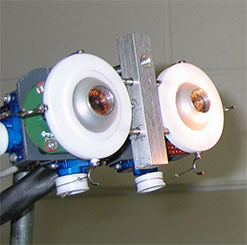A customized interface will make typing on the computer faster and easier

Insert the key into the ignition switch of a luxury car and get in, the seat and steering wheel will automatically adjust to the specific driver's body measurements pre-programmed to them. Walk through the rooms in Bill Gates' castle and the light and background music will suit your preferences, but open any computer program and you will most likely be required to adhere to the design team's ideas about button sizes, fonts and page shape.
Off-the-shelf designs are especially frustrating for the disabled, the elderly, and all those who have problems with mouse control. A new design approach recently developed at the University of Washington examines each user's skills and creates a mathematically adapted version for the user's optimal interface, visual limitations and motor abilities. The paper describing the method, which for the first time offers access to instant customization of the user interface, was presented in July at the meeting of the Society for Advanced Artificial Intelligence held in Chicago.
"Assistive technologies were developed based on the assumption that the person is the one who needs to adapt to the technology. We tried to reverse this hypothesis and make the software human-friendly," said the project's lead researchers Krzysztof Kajos, a doctoral student in the Department of Computer Science and Engineering at the University of Chicago and the Jacob Wald Professor at the University of Washington's School of Informatics.
Tests showed that the system was able to reduce the gap between disabled and normal users by 62%, and the disabled users preferred the automatically created interface. "This showed that the automatically created and customized interface does work, and that the technology is ready to enter the mainstream," said Wald.
The system, known as Supple, begins with an evaluation test of actions such as the user pointing with the mouse, dragging and clicking. An arc of dots appears on the screen and the user has to quickly click on each dot as soon as it is illuminated. The system repeats the task of changing the size of the dots. Another test asks the user to click and drag, select from a list and repeatedly click on the same point. Users can move the cursor using any type of device. The test takes 20 minutes for healthy people and up to 90 minutes for people with motor disabilities.
At this point, optimization software comes into play that calculates how long it took a person to complete a variety of computerized tasks, and within seconds it creates the interface that maximizes the user's accuracy and speeds up the use of specific software.
The researchers tested the system last summer on six healthy people and 11 people with motor disabilities. The result showed that uniformly built interfaces are not suitable for everyone. A man with cerebral palsy used his chin to control a trackball and was able to move the cursor quickly but not in the desired direction. Based on his ability test, the system created a user interface for him where all the targets were larger than usual, and lists were expanded so that minimal scrolling was required.
In contrast, a woman who suffered from muscular dystrophy and who participated in the study used both hands to move a mouse. She was able to make precise movements but moved the mouse very slowly and with great effort due to her weak muscles. Based on these results, Supella automatically created an interface with small, tightly packed buttons.
There is a great temptation to think that we can continue with the universal interface. But if we look at the results, the design that helps one person will be very difficult for a person suffering from various disability problems, Gajos said.
From the perspective of accessibility, it's always better to change the environment than to use dedicated assistive technologies, says Kurt Jenson, a professor of rehabilitation medicine, also at the University of Washington, who coordinated the trials. "Supple can be useful for many people with functional disabilities, from old age, to people with weak vision, to those who suffer from shocks.
The software can also be used to create an interface that can adapt to different sizes of screens, for example for handheld computers. However, the implementation of the system will require a completely different approach to designing computer interfaces, says Gakajos. He predicts that the first implementations of the system will be mainly for web applications. The researchers also plan to adapt the interfaces designed in the traditional way to changes using Safel.
